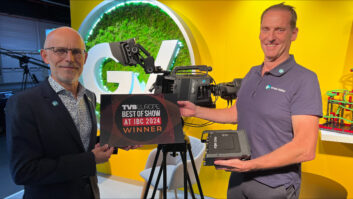A recent event, hosted by Shure UK at its Rose Shure Customer Experience Centre in central London, featured keynote speeches and panels from industry and national regulators about spectrum planning at the 2024 Paris Olympics, together with a range of global spectrum-sharing initiatives.
The event, Global Perspectives on Spectrum Sharing, sponsored by Wireless Innovation Forum (WInnForum), was attended by senior regulators from the UK (Ofcom), Germany (BNetzA), France (ANFR) and US (NTIA), alongside UK government officials from the MOD and DSIT, plus industry experts representing a broad array of spectrum users. The link to the event, including video and presentations, is here.

The outcome of the World Radio Conference 2023 (WRC-23), at which the future of the 470-694 MHz band in Region 1 (Europe, Russia, Middle East and Africa) was one of the most contentious agenda items, avoided a third successive blanket re-purposing of UHF to mobile broadband. Nominally at least, the item was kicked into the long grass until WRC-31. For the foreseeable future, broadcasting (Digital Terrestrial Television) remains the primary user of the band, which has been shared for decades with great success by Programme Making and Special Events (PMSE) applications, typically comprising wireless microphones and in-ear monitor systems.
Reliability of access to spectrum in the 470-694 MHz band across the world by PMSE, albeit on a shared basis with broadcasting, created the conditions for the development of a mature PMSE equipment ecosystem. As was made clear from the presentation from France’s regulator, Agence Nationale des Fréquences (ANFR), on spectrum use and lessons from the Paris 2024 Olympic Games, the UHF band remains the overwhelmingly dominant spectrum resource for audio PMSE, with 89 per cent of audio links for the Games (12,345 of a total 13,858) licensed within 470 – 694 MHz.
Even setting aside the Olympics as an outlier (bidding countries must provide a government-backed guarantee of spectrum availability), cultural and creative industries (CCI) growth across Europe continues to outpace many other sectors. The largest PMSE events will continue to require a significant amount of available UHF spectrum and many venues, including media complexes, production studios, theatre districts and large conference venues, see ubiquitous use of PMSE and significant daily demand for spectrum in the band, as highlighted by Tuomo Tolonen, Shure’s senior director of global market development.
As competition intensifies for spectrum in some highly coveted bands, the feasibility of sharing arrangements between services is being examined more closely. Cristina Data, Ofcom’s director of spectrum policy and analysis, noted that a priority for the UK’s regulator was that, “people and businesses have connectivity when and where they need it”, and that other than wireless broadband there is a plethora of other use cases for spectrum across a range of industries.
Alexander Kühn, head of international and national spectrum management at German regulator BNetzA, emphasised the role of engineering, practical testing and real-world trials in problem-solving, with the protection of incumbents stated as a key objective in new spectrum sharing scenarios.
They both hint at the promise of more tailored spectrum management approaches in the decade to come. It is hoped that the days of PMSE spectrum policy being residual to the spectrum fortunes of other services will come to an end. PMSE equipment manufacturers and users are also highly innovative, investing in the development of increasingly efficient digital equipment, and more recently new Wireless Multichannel Audio System (WMAS) technology. But innovation is not a silver bullet and the PMSE sector cannot innovate its way out of further spectrum loss.
If PMSE’s future, and its future as the engine of content creation, is to be both protected and given room to reach its full potential, it will require a combination of boldness and novel thinking by regulators across Europe.







